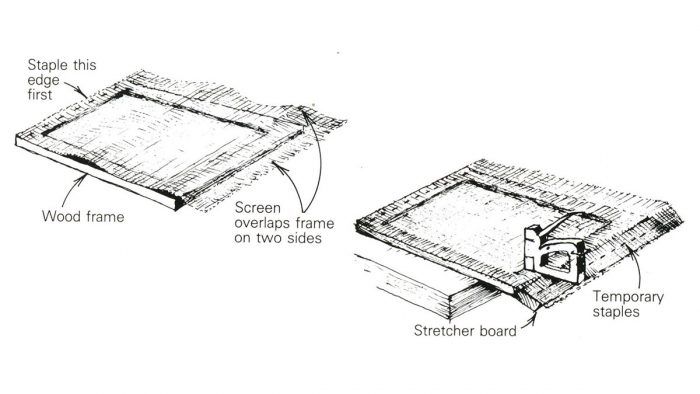Stretching Screens
Learn how to stretch screens like a professional using a DIY stretcher board.

It can be more than difficult to stretch screening evenly across a frame without bags, sags and zigzags. But I’ve found that with the help of a stretcher board, I can get professional results every time. As shown in the drawing, I run the screening a few inches long in both directions. After stapling the screen to one of the short sides of the frame, I staple the other edge of the screen to a stretcher board.
After stapling the screen to it, I hang the end of the frame that I’m working on over the end of a table and press down on the stretcher board. This tensions the screen, and with my free hand I staple the screen to the frame. After removing the staples from the stretcher board, I repeat the process on the unstapled sides of the frame. The screen comes out straight and taut.
— David Tousain; Coon Rapids, IA
From Fine Homebuilding #58
RELATED STORIES
Got a Tip?
Do you have any great tips like this one on how to stretch a screen evenly across a window or door frame? Share your methods, tricks, and jigs with other readers. Tag them @FineHomebuilding on social, email them to us at [email protected], or upload them to FineHomebuilding.com/reader-tips. We’ll pay for any we publish.






























View Comments
I'll try to adapt it for rescreening my modern aluminum patio door frame. ...but who staples screening to a wooden screen frame? Was this tip submitted in the 1950's?
Our cabin has a five year old large screened porch that consists of 30 inch wooden screen doors set between 4x4 posts. Can't imagine doing this with aluminum doors. I think wooden screens may still have a bit of life in front of them...
And, as is too often the case, it looks like a a drawing was omitted.
Suburbanguy, how a bout the thousands of people who have wooden screen doors and /or wooden screen frames for their windows? Not everyone lives in a house just like yours.
Having just done an aluminum patio door, I was echoing some of the thoughts about aluminum frames- they're more flexible than wood and you have to be careful not to bow them by overtensioning the screen. It hasn't been a huge problem for me, but i It occurred to me the stretcher board could help by applying an even stretch along the length of the frame.